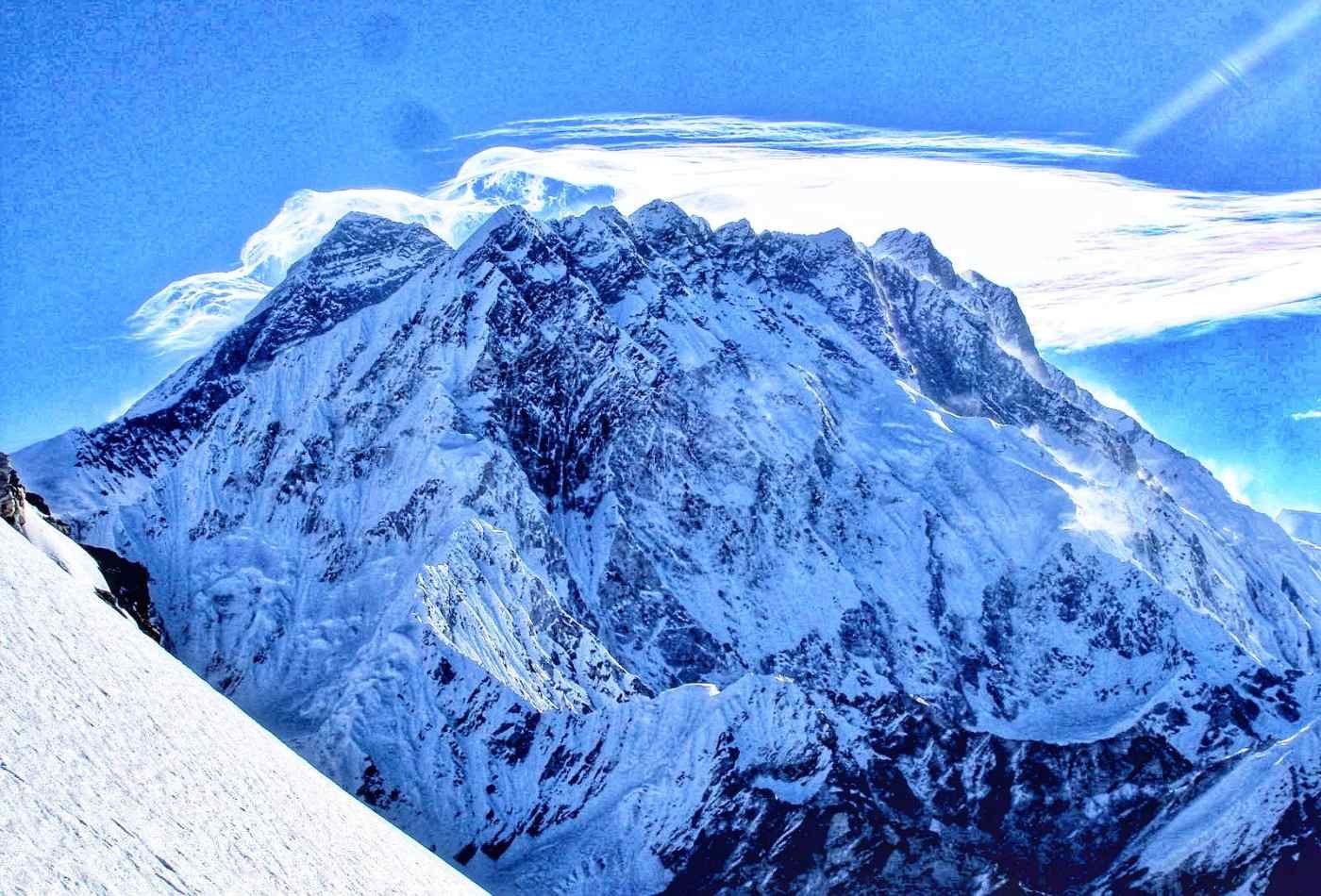
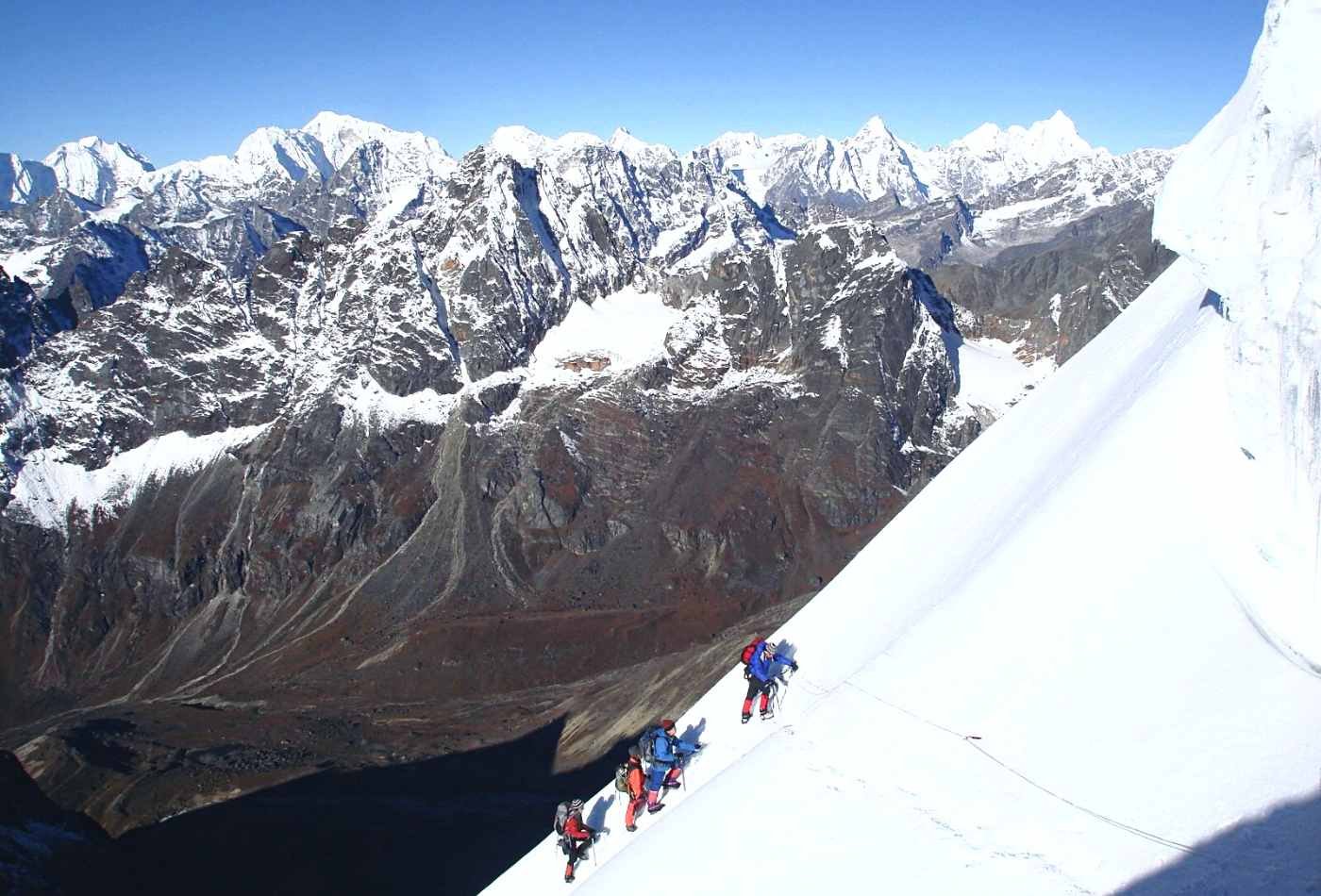
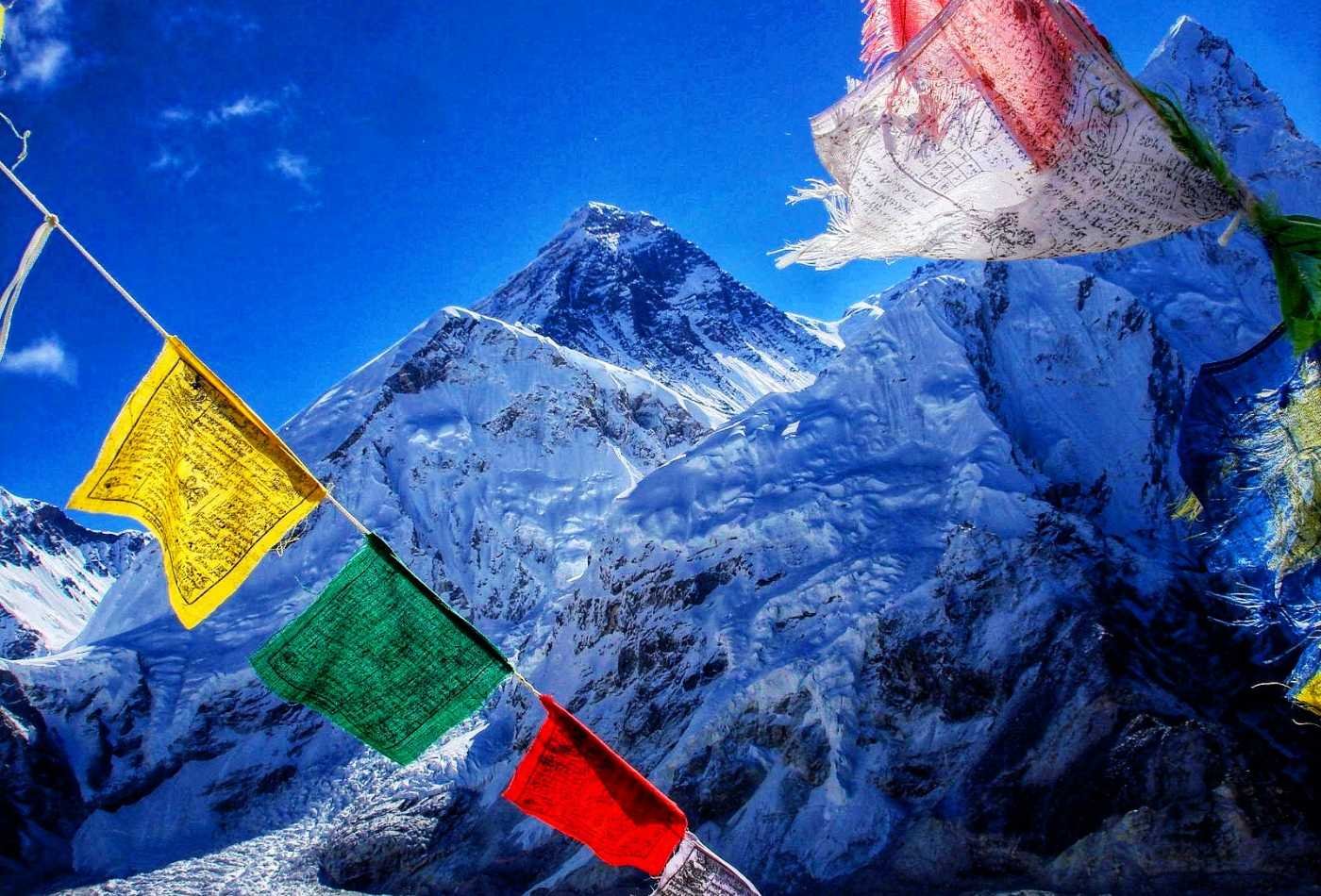
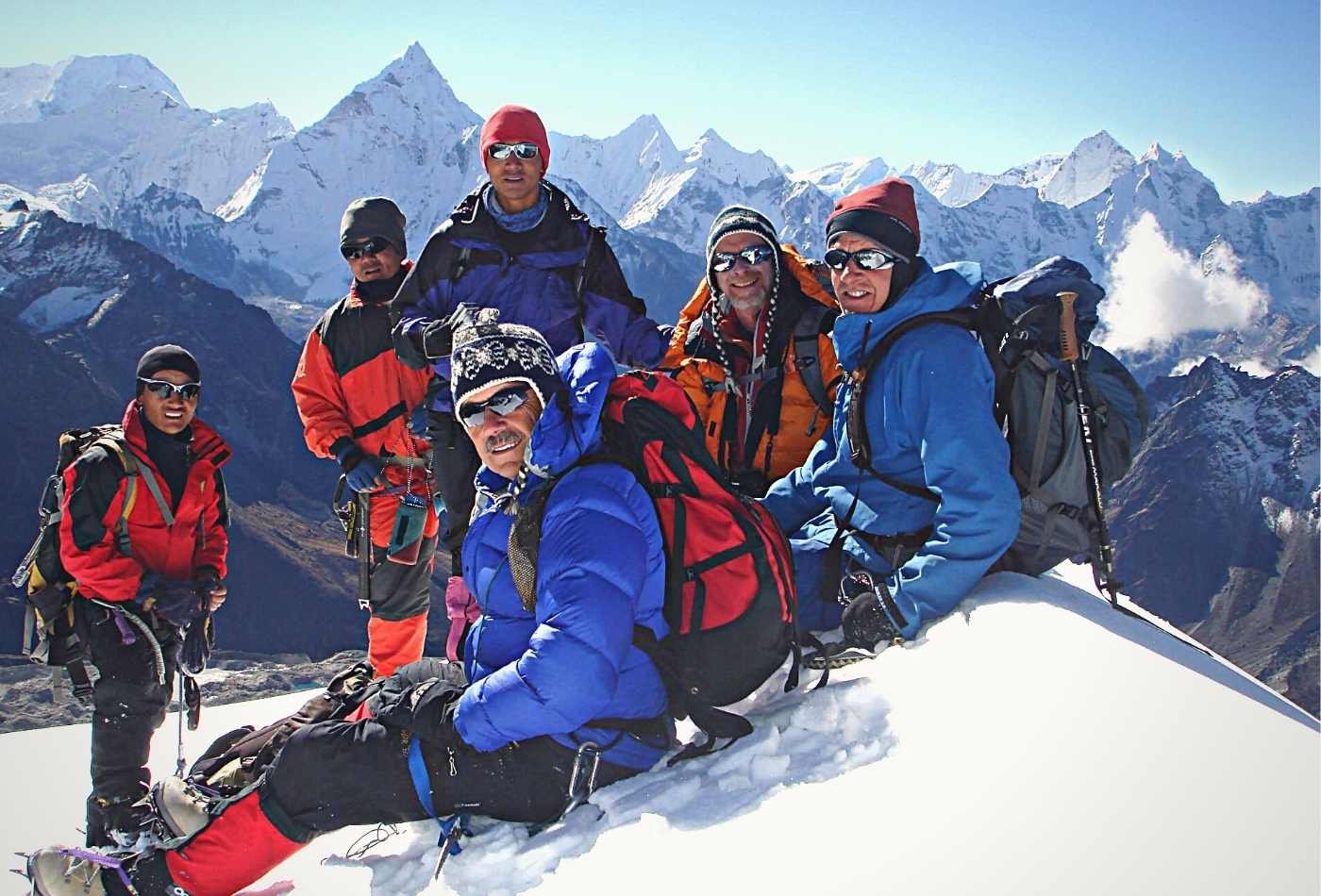
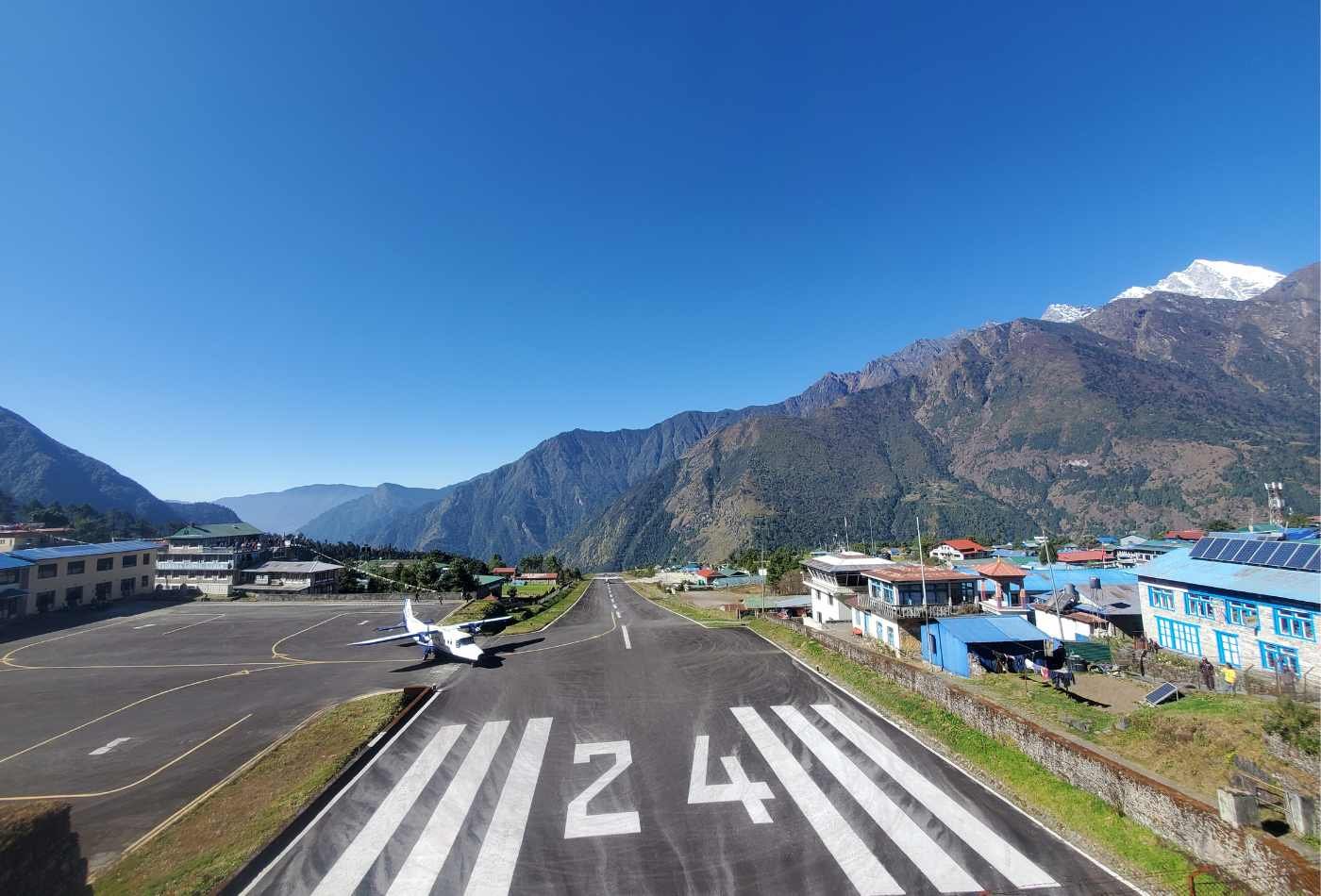
Everest Base Camp and Lobuche Peak Climbing 19 Days
TRIP HIGHLIGHTS
- Ascend a 20,000 ft peak within a relatively short timeframe
- incredible views of the world's giant mountains
- Visit Sherpa villages and meet local
- Visit Hindu & Buddhist Temples, Monasteries
- A great introductory expedition into Himalayan climbing
- Scenic Mountain flights to and from Lukla
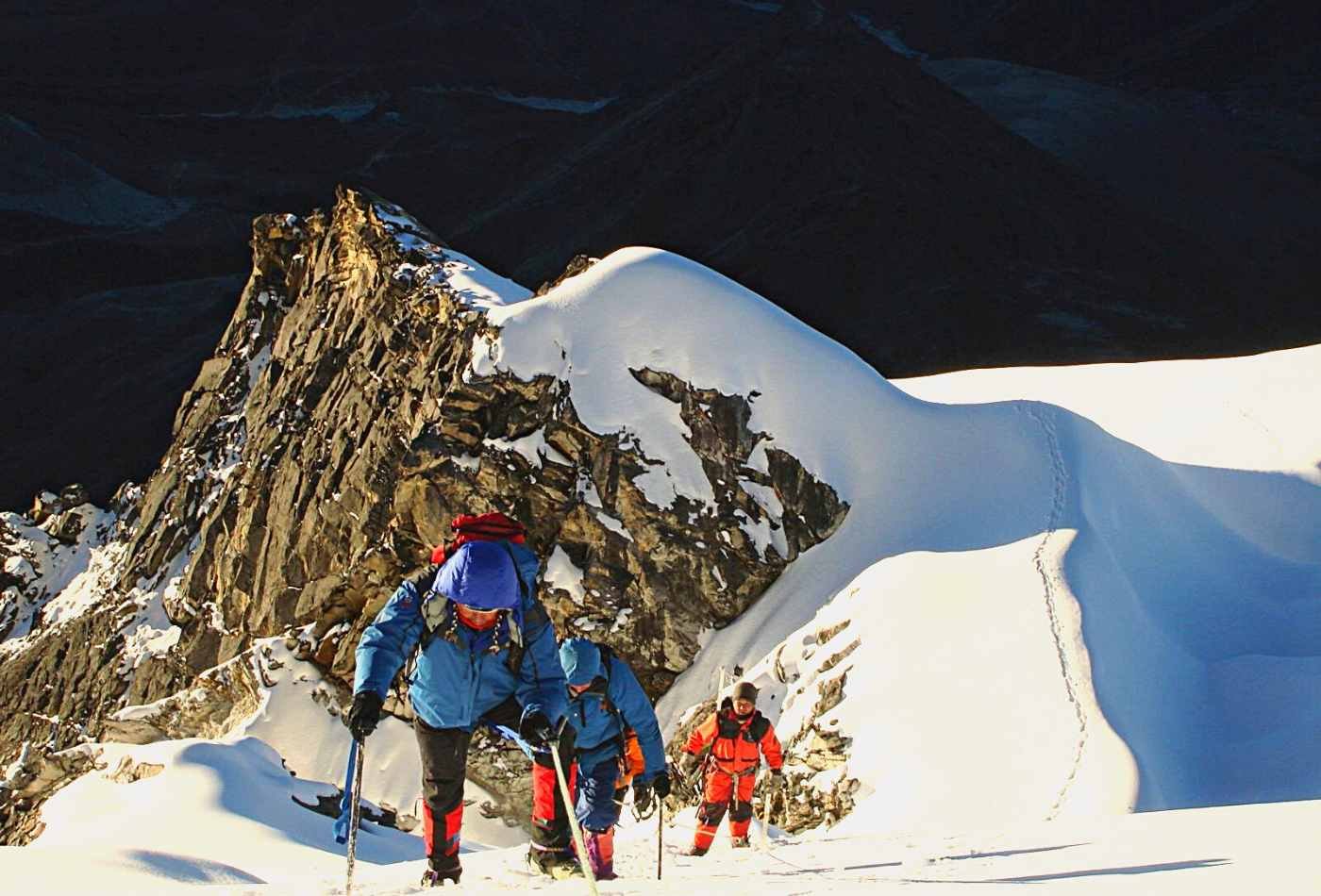
Cost From: $4800 PER PERSON
$550 SINGLE SUPPLEMENT
Return Guests get a 10% discount on all Trips!
-
Trip Type:
Trek+Climb
-
Group Size:
2-12 Trekkers
-
Best Season:
Spring & Autumn
-
Max Altitude:
6,119 meters
20,075 feet -
Start-End:
Kathmandu
-
Daily Activity:
Approx 6-7 hrs hike
Location:
Sagarmatha National Park, Solukhumbu, Nepal
- Fly into Tribhuvan International Airport (KTM)
DESCRIPTION
The Everest Base Camp Trek is a popular trek in the Nepal Himalayas that takes you to the base camp of Mount Everest, the highest mountain in the world. Trekking through some of the most beautiful and rugged terrains in the world, including forests, glaciers, and high-altitude passes. Along the way, you'll have the chance to see stunning views of the surrounding mountains, including Lhotse, Nuptse, and Ama Dablam, and visit local villages and monasteries.
Lobuche Peak is considered a more challenging climb than some of the other peaks in the region and requires a high level of physical fitness and technical climbing skills. First climbed in 1984 by Laurence Neilson and Ang Gyalzen Sherpa, Lobuche Peak is an approachable yet challenging climb. On the way to High Camp, we pass a hidden lake and soak in the views of Ama Dablam, Cholatse, Pokalde, Thamserku, Kantega, and more! The summit ridge consists of steep alpine ice requiring fixed lines. The views and exhilaration of standing on the summit of Lobuche Peak are well worth the effort.
The Everest Base Camp Trek and Lobuche Peak climbing are physically demanding activities requiring a good level of fitness and proper preparation. Participants should be in good physical shape and have a background in basic mountaineering and/or a history of physical exercise.
TRIP ITINERARY
DAY- 1: ARRIVE IN KATHMANDU.
Book your flight for Tribhuvan International Airport (KTM) as your itinerary. Your guide will pick you up and transfer you to your hotel. She/he will brief you about your next day's schedule.
Accommodation: Hotel TibetMeals included: Dinner
DAY- 2: KATHMANDU SIGHTSEEING AND TREK PREPARATION.
After breakfast, your guide will pick you up to explore Kathmandu. Three major Kathmandu heritage sites, Boudhanath, one of the largest Buddhist stupas in the world. Pashupatinath is a Hindu temple dedicated to Lord Shiva and is located in Kathmandu, Nepal. This temple was classified as a World Heritage Site in 1979, and Kathmandu Durbar-Square is an old royal palace of the former Kathmandu Kingdom. Evening welcome dinner with the group, briefs about the next day's activities.
Accommodation: Hotel Tibet
Meals included: Breakfast/Lunch/Dinner.
DAY- 3: FLIGHT TO LUKLA AND TREK TO PHAKDING.
Fly to Lukla (9,350ft). It takes 40-45 minutes and is an adventure, with great views of the landscape and mountains. After meeting our crew, we will start our trek by heading up the Dudh Koshi Valley on a well-marked trail to Phakding. (8562ft)
Accommodation: Local Tea HouseMeals included: Breakfast/Lunch/Dinner.
DAY- 4: Trek Phakding to Namche Bazaar.
After breakfast, we follow the Dudh Kosi river. This day's walk takes us through magnificent forests with glimpses of the mountains ahead. We cross the river several times by bridge as we pass through the sherpa villages. A final bridge brings us to the foot of the steep climb to Namche. If the weather permits, catch the first glimpse of Mt Everest along the way. Namche is a prosperous Sherpa town and an important trading center. It has a weekly market on Friday afternoon and Saturday morning.
Accommodation: Local Tea House
Meals included: Breakfast/Lunch/Dinner.
DAY- 5: Acclimatize day in Namche.
Accommodation: Local Tea House
Meals included: Breakfast/Lunch/Dinner.
DAY- 6: Trek from Namche Bazaar to Tengboche Monastery.
The trek from Namche to Tengboche involves moderate ascent and descent, with some steep sections. Along the way, you'll have the chance to see stunning views of the surrounding mountains, including Everest, Lhotse, and Ama Dablam. You'll also pass through forests and small villages and may have the opportunity to interact with local people and learn about their way of life.
Accommodation: Local Tea House
Meals included: Breakfast/Lunch/Dinner.
DAY- 7: Trek from Tengbouche to Dingbouche.
After breakfast, We hike to Dingboche via the small village of Pangboche. We follow the Imja River, which flows directly east of the town to Pangboche, a large Sherpa village at the foot of Ama Dablam. We will have lunch at Shomare small sherpa village then continue to follow the Imja River to Dingboche.
Accommodation: Local Tea House
Meals included: Breakfast/Lunch/Dinner.
DAY- 8: Acclimatize day in Dingboche.
Accommodation: Local Tea House
Meals included: Breakfast/Lunch/Dinner.
Day 9: Trek from Dingboche to Lobuche.
From Dingboche, ascend the small ridge, then walk will now be relatively flat on wide-open fields. Remember that there’s no rush – take your time and ensure you’re well hydrated and enjoy the view of Taweche, Cholatse, and Lobuche Peak, which we will climb in a few days. After 2 hour trek, you will cross the Khumbu Khola at Dughla and stop for light lunch at the foot of the huge terminal moraines of the Khumbu Glacier flowing off Everest. After Lunch, there will be a solid and quite steep climb on a rocky trail to the top of the moraines. You’ll pass a line of memorial cairns (stacks of stones) built in memory of the climbers who have died on various Everest expeditions. From here, the view is spectacular. Then follow the valley stream to Lobuche.
Accommodation: Local Tea House
Meals included: Breakfast/Lunch/Dinner.
Day 10: Trek from Lobuche to Gorakshep and hike to Everest Base Camp.
This is the big day. From Lobuche, follow the broad valley that runs parallel to Khumbu Glacier, with a gradual ascent enabling you to build the slow, steady rhythm required when walking at a high altitude. You will make a series of small ascents and descents over a rocky trail lined with cairns, eventually leading to the surprising glacial sands of Gorak Shep. We will have quick lunch, gear up appropriately, Then head off toward Everest Base Camp. The trek to the base camp is around six hours both ways. You can see glorious glaciers, lakes, caves, and the Khumbu Ice Fall that flows from the Western Cwm. Base camp will be full of climbers during April and May, but there will be hardly anyone in the October season.
Accommodation: Local Tea House
Meals included: Breakfast/Lunch/Dinner.
Day 11: Early morning hike to Kalapathar and trek to labouche Base Camp.
In the morning, we climb to the summit of Kala Patar, a small peak across the valley from Everest on the lower slopes of Pumori, giving way to stunning Everest views. Back to the tea house, have breakfast leave the Gorakshep, and descend to Lobuche base camp.
Accommodation: Tent
Meals included: Breakfast/Lunch/Dinner.
Day 12: Training and Rest Day.
At Lobuche Base Camp, we are rewarded with beautiful views of Ama Dablam, Cholatse, Thamserku, Kantega, and other peaks. After breakfast, we will have time to train on fixed lines, crampons, and ice axe. Packing for the summit and discussing the climb.
Accommodation: Tent
Meals included: Breakfast/Lunch/Dinner.
Day 13: Climb to High Camp.
Take it easy in the morning, Have breakfast, then climb to the high camp rocky terrain, which may require technical climbing equipment. Our climbing sherpa will be with you all time. A balanced diet & drink plenty of fluids are essential to help your body adapt to the altitude and get ready for the summit.
Accommodation: Tent
Meals included: Breakfast/Lunch/Dinner.
Day 14: Summit Labouche Peak and trek to Pheriche.
Accommodation: Tea House
Meals included: Breakfast/Lunch/Dinner.
Day 15: Trek from Pheriche to Namche.
We are leaving behind Imja valley we go back to our exact route. Following southwards of the Imja river and catching the last sight of Tengboche monastery, we descend off the ridge of Phunki Tenga and cross the Dudh Koshi river. Slightly climb to Khyangjuma, then we follow the main route to Namche. Catch the last sight of the magnificent Khumbu mountain, and we return to our comfort zone in Namche.
Accommodation: Tea House
Meals included: Breakfast/Lunch/Dinner.
Day 16: Trek from Namche to Lukla.
After breakfast and necessary backpacking, we continue to descend to Monjo. The check-out national park, and following the southwards of Dudh Koshi river, we stop in Phakding for Lunch. Around 3 hours walk from Phakding, we check in at Lukla and join dinner with porters in the evening.
Accommodation: Tea House
Meals included: Breakfast/Lunch/Dinner.
Day 17: Flight back to Kathmandu
Early morning short flight from Lukla to Kathmandu, approximately 20-30 mins. Check-in hotel, rest, and shop. Your guide will update you about the next day's schedule.
Accommodation: Hotel Tibet
Meals included: Breakfast
Day 18: Leisure day in Kathmandu/Sightseeing
After breakfast guide will pick-up you up from the hotel, Bhaktapur Durbar Square is 13 km east of Katmandu and is listed as a World Heritage site. It’s famous for its art and architecture. Many famous temples and statues are the main attraction of the Bhaktapur Durbar Square.
Accommodation: Hotel Tibet
Meals included: Breakfast/Lunch/Dinner.
Day 19: Final Departure
Our office staff will drop you at the airport 3 hours before the flight schedule.
Meals included: Breakfast
Dates & Prices
For online booking, you will pay a deposit of $ 500 now, and the remaining balance is due 60 days before your trip start date.
TRIP DETAILS
WHAT'S INCLUDED
-
Airport pick-up and airport/hotel transfers
-
Standard accommodation in Kathmandu with breakfast
-
Guided city tour in Kathmandu, monument/temple entrance fees
-
Meals during the trek
-
Lodge/tent accommodations during the trek & Climb
-
English-speaking guide and climbing sherpa
-
Local staff and porters to carry luggage and climbing gear during the trek
-
Food, accommodations, salary, insurance, equipment, and first-aid for all staff and porters
-
Everest National Park fees, trekking, and climbing permits
-
Domestic roundtrip airfare Kathmandu–Lukla, including airport departure tax
WHAT'S NOT INCLUDED
-
Lunch and dinner in Kathmandu
-
Your travel, medical and rescue insurance (compulsory)
-
International airfare and airport departure tax
-
Nepal entry visa fee (US$ 40 per person)
-
Alcoholic, cold and hot drinks, laundry
-
Personal trekking Equipment
-
Tips for trekking guides, climbing sherpas, porters, and driver
-
Any other expenses due to delays or bad weather
WHAT GEAR TO BRING
Once you book this trek you’ll receive access to a printable, downloadable trip information packet with a detailed packing list
FAQ
How do I sign up for a trip?
Booking a trip is easy. Call us at 734-997-7229 or 303-834-5512, or Email us at info@imperialexpedition.com. Online bookings are made via the ‘Book Now button available on each trip page. Once we confirm your booking, we’ll send you comprehensive information regarding visas, vaccinations, gear, clothing, and arrival details to ensure you are fully prepared for your adventure.
How fit do I need to be to trek in the Himalayas?
You should be moderately fit, exercise regularly, and enjoy active vacations and walking and hiking in mountainous terrain. For the Everest base camp trek, you should be able to run for an hour without stopping at any speed and still feel good to continue – OR – walk for 5-6 hours in a day with rests. Trekking is an endurance sport. Mostly you need a good attitude, which will go a long way toward the success of reaching your goal.
When is the best time to trek and climb in the Himalayas?
-
Fall (September-November): Fall is considered the best time for trekking in Nepal. The weather is excellent at this time, allowing for clear blue skies and tantalizing mountain views. Temperatures are moderate. Occasional short storms may bring snow to higher altitudes.
-
Winter (December-February): Winter brings heavy snowfall mostly at higher altitudes. This can be a good time for cultural tours and trekking at lower elevations.
-
Spring (March-May): Spring is a good time for trekking and climbing in Nepal and Tibet. The rhododendrons, the national flower of Nepal, make the hillsides a colorful paradise during the spring. It is mildly warm at lower elevations and at higher elevations, the mountain views are excellent while the temperature is quite moderate. If you trek to Everest base camp in the spring, you will have the opportunity to meet world-renowned climbers, as several Everest expeditions will be assembled at base camp.
-
Summer/Monsoon (June-August): The monsoon during the summer months can make travel in Nepal wet, muddy, warm, and often humid. Strong monsoon rains don’t usually last long, and often end with large and wonderful rainbows. However, the streets in Kathmandu can be muddy and landslides sometimes occur in the mountains. It is recommended to carry insect repellent when trekking during these months.
What sort of experience do your guides have?
Our guides are dependable, competent, and highly qualified with more than ten years of trekking experience, leading trips, treks, climbs, and expeditions in the Himalayas. Our guides speak English and the local language. We are trained in first aid and CPR. Most importantly, our guides are friendly and enjoyable and are passionate about sharing the rich cultures, traditions, and natural beauty of Nepal.
What is the routine on the trek?
Most trekkers normally start their day early around 7:30 to 8:30 am after a hot breakfast. The morning sun offers nice mountain views. You will carry a light pack for your camera, water, a jacket, and a wind layer. Around noon we will reach the lunch stop where we will spend time drinking tea, resting, and having lunch. After lunch, we normally walk for 2 to 3 more hours before arriving where we will stop for the evening. Here at the lodge we will have hot tea and relax for the rest of the day. Our day ends with dinner and then off to bed in single or double rooms in the trekking lodge.
What type of shoes or boots should I wear?
The proper footwear depends on the trek and on the trekker. Most hikes can be done in comfortable running shoes while longer more strenuous treks may require sturdy but lightweight hiking boots. It is best if you purchase shoes and boots long before arriving in Nepal. We advise that you wear your boots prior to the trek to break them in – in order to prevent blisters, which can be debilitating on the trail.
How big will the group be?
We try to bring together a small group of like-minded people. Our trekking groups are generally from 6 to a maximum of 12 members, although we can accommodate smaller groups and solo trekkers as well.
Do you arrange private or family treks?
Yes, if you would like to travel independently or with friends, family or colleagues, you are invited to choose the trip that best suits your group and the trip dates according to your schedule. We are happy to consider any number of trekkers. Our maximum is not more than 50 at a time. The cost per person for private trips is negotiated on the basis of group size, trek area, and duration.
How long do we walk each day?
Our trips are classified into three categories according to the level of difficulty. Easy adventure treks are about a week to 10 days in duration. They generally don’t go above 13,000 feet (4,000m). You can expect to be hiking/walking for around 4-5 hours a day. Moderate to fairly challenging treks are longer treks that go into a high mountain country above 13,000 feet (4,000m). Physically these trips are more demanding and tiring and may involve 6-8 hours of trekking along rocky trails in high Himalayan terrain. Strenuous treks are longer treks that go beyond the normal activities of trekkers and tourists. These include ice climbing and mountaineering expeditions. Physically challenging, these trips may involve 7-9 hours of trekking in a day and are likely to include unfavorable weather conditions and strenuous activities. Some level of experience may be required for these trips.
What type of food is served during a trek?
In general, while trekking breakfast may include a choice of porridge, muesli, omelet, fried or scrambled eggs with chapattis or bread. Lunch and dinner are generally pasta, potatoes, or rice with or without cooked veggies and/or eggs. Meat is also available, however, it is recommended to adopt a vegetarian diet. As long as the meat is stored and cooked properly, meat dishes are also safe. Tea, coffee, and hot chocolate are available at all meals. Your guide will do his/her best to make sure all food is well cooked. At some restaurants in Kathmandu, the vegetables are soaked in iodine and thus fresh salads are safe to eat. While trekking it is best to avoid raw vegetables unless you can peel them yourself. The rule is: cooked, peeled, boiled – or forget it! During the trek, you can choose what you like from the menu in the lodge. There will also be plenty of snacks available such as biscuits, popcorn, candy bars, and soft drinks. In some areas, you will find fresh fruit in season.
What are the overnight accommodations like?
In cities, you will be staying in hotels and guesthouses that are similar to those in the US with private bathrooms, showers, TV, phone, AC, etc. If you prefer luxury hotels we can make those arrangements as well. While trekking in the mountains the accommodations will depend on whether you are camping or teahouse trekking. If you are on a camping trek, then you will be sleeping in a tent. The trekking lodges or teahouses are simple shelters. There is no central heat. In the dining room where meals are served, there is often a wood-burning stove that heats that room only. The guest rooms are not heated so you will need a good quality sleeping bag, which can be rented in Kathmandu. The guest rooms are usually small and sleep one or two trekkers. The walls are thin so earplugs are a good idea for light sleepers. The bathrooms are down the hall or outside. Nowadays, there are also a few ‘luxury’ establishments along the popular trekking routes. If you are interested to upgrade, let us know and we can make those arrangements.
What happens in case of an emergency?
In the case of a serious illness or a life-threatening emergency during your trek, a helicopter rescue will be initiated. You are responsible for all the expenses incurred in such an evacuation. It is required that you have insurance that covers emergency helicopter evacuation throughout your trip. However unlikely, we are prepared for emergencies, and your guide will respond quickly to get any necessary medical help. We aim to avoid such circumstances with education and a large dose of preventative medicine.
Is it possible to deviate from the itinerary?
Our specific itineraries are custom crafted with you in mind. Once we agree on a plan, we can always make minor changes and adjustments while en route. The itinerary acts as a general plan for the trip. However, there are often local events, festivals, or happenings that may capture our attention. As long as everyone in the group agrees on these changes, that is fine. Major changes to the itinerary may be made if there are political or environmental concerns. Your guide will help to make any necessary adjustments. Our trips are adventures that may take you into remote regions where unforeseen circumstances may contribute to the need for a change in the itinerary.
Any suggestions on what to do and what not to do with respect to the Nepalese culture?
-
The most common greeting in Nepal is “Namaste” which is performed by placing the palms together and bowing as if praying.
-
Before entering a Nepalese home, temple or monastery remember to remove your shoes and place them neatly side-by-side.
-
Be careful not to use your spoon, fork, or hands to touch another person’s food, plate, cooking utensils, or even the serving dish. Do not eat from other people’s plates and do not drink from other people’s water bottles or glasses. This is considered to be impure by the Nepalese.
-
Never touch anything with your feet. The feet and the floor are considered dirty.
-
While traveling, dress appropriately. Women should avoid short skirts and sleeveless shirts.
-
Seek permission before entering a Hindu temple. Many Hindu temples do not allow non-Hindus to enter.
-
Leather is prohibited inside temples because cows are considered sacred and are not used for slaughter.
-
Walking around temples or Buddhist stupas is traditionally done clockwise.
-
Be sure to ask before taking photographs of the locals. Some people believe part of the soul is taken when a picture is snapped.
-
Public displays of affection between a man and a woman are frowned upon and are not generally accepted.
-
When the Nepalese shake their head from left to right, they may mean, “Yes”.
-
Develop a genuine interest in Nepal and meet and talk to the Nepalese people. Do your best to respect their local customs and traditions.
Payment methods
What about transferring trips?
Tours and trekking trips may be transferred to the next year or to another date, however, the transfer must be made 90 days or more prior to departure. Otherwise, if the transfer is made 90 days or less prior to departure, you must pay the cancellation fees as outlined above. There are no fees for transferring trips more than 90 days prior to departure. However, for climbing trips and expeditions, if you would like to transfer your trip to the next year or to different dates, there is an automatic transfer fee of $1,000 that must be paid to Imperial Expedition.
Should I purchase trip cancellation insurance?
If you must cancel your trip due to illness, injury, or death of yourself or an immediate family member, trip cancellation insurance protects all your deposits and payments for both air and land costs. It is recommended that you buy trip cancellation insurance but not required.
What if I have to cancel?
If you decide to cancel your trip, the following fees apply and are due to Imperial Expedition prior to departure when we receive written notice of your cancellation. Cancellation Fee Schedule for tours and treks:
- 90-81 days prior to departure You forfeit half the deposit
- 80-60 days prior to departure You forfeit the deposit
- 59-31 days prior to departure You forfeit 50% of the total amount
- 30 or fewer days prior to departure You forfeit the entire cost of the trip
Cancellation Fee Schedule for Climbing Trips and Expeditions:
- 180-150 days prior to departure You forfeit
- 149-89 days prior to departure You forfeit 50% of the total amount
- 90 or fewer days prior to departure You forfeit the entire cost of the trip
What if Imperial Expedition cancels my trip?
Imperial Expedition reserves the right to cancel all or a portion of a trip due to political or environmental circumstances, which may hinder trip operations or for any other reasons beyond our control. In the event of such a cancellation, we will give a full refund for the cost of the trip. However, Imperial Expedition is not responsible for additional expenses incurred by you in preparing for the trip, visa fees, gear, insurance, or medical expenses prior to the trip. If international air tickets have been purchased, the airline’s refund policy applies.
What other expenses should I consider?
Medical advice and inoculations, health and travel insurance, travel and trekking gear, international airfare, Nepali visas, airport tax, spending money, and most meals are not included in the cost of your trip.
How much should I budget for tipping?
Your support team will work hard to please you during your trip. They will appreciate receiving a tip at the end of their service. The amount you give depends on you and your appreciation of their work. We recommend giving from $200 – $300 total in tips to your porters.
Contact Us
ACCOMMODATIONS
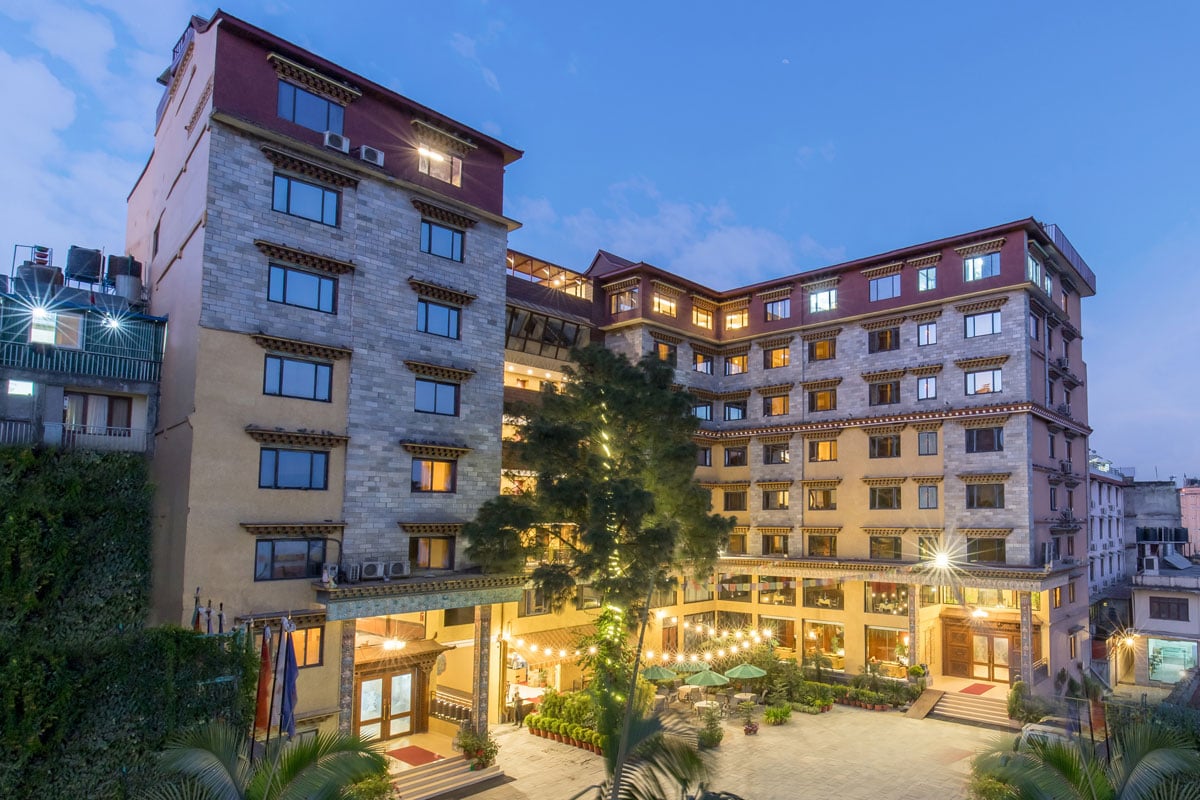
HYATT REGENCY KATHMANDU
4 Nights
Walking distance from the UNESCO Heritage Site of Boudhanath Stupa, Hotel Tibet International is a 4-star standard boutique hotel that showcases the Tibetan-Buddhist culture and heritage in Kathmandu. Inspired and decorated in Tibetan style.
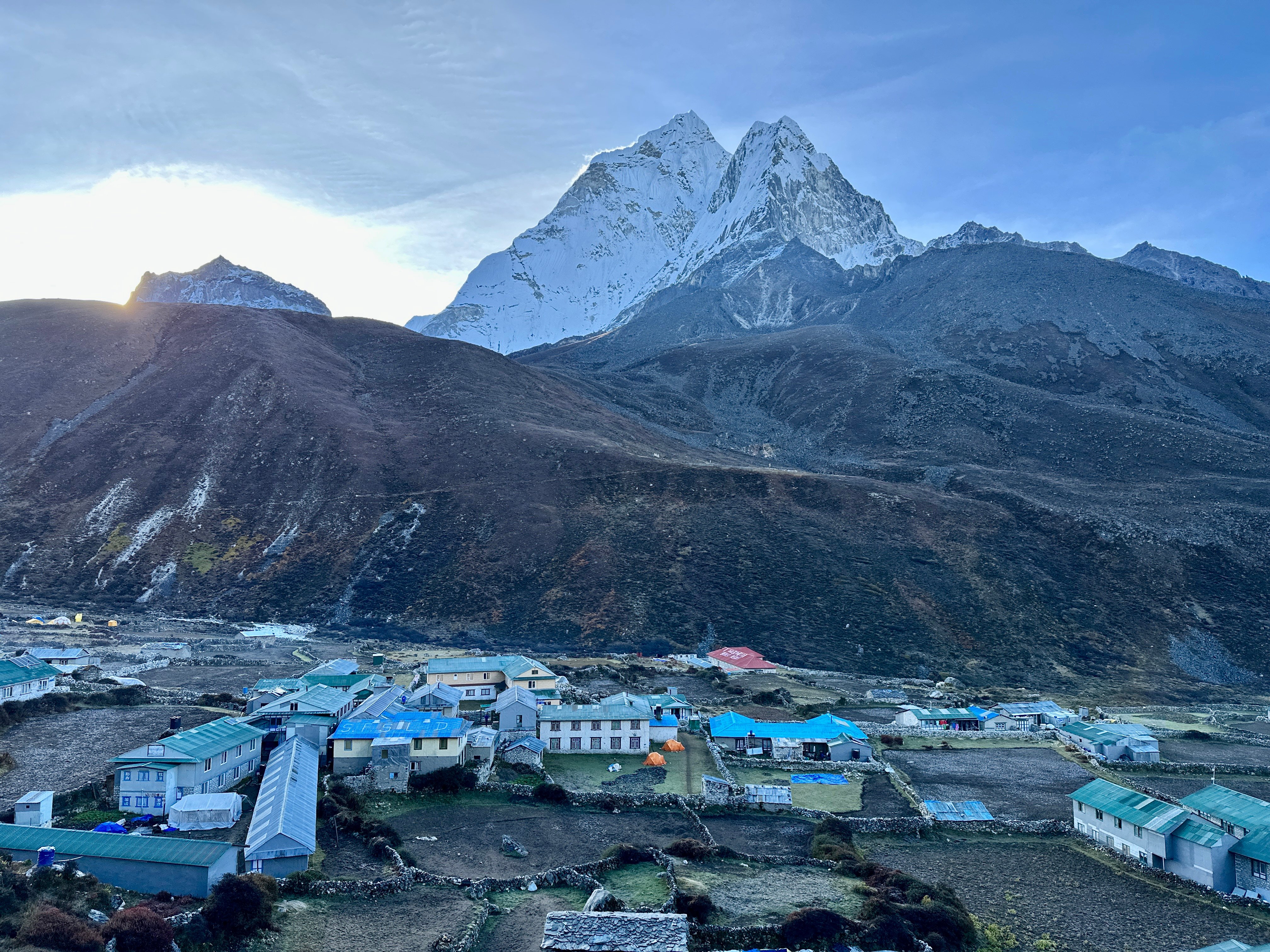
During The Trek & Climb
11 nights at a local Tea House
3 nights tent
Tea houses are accommodations along trekking routes in Nepal that offer basic lodging and meals. All tea houses own and operate by local families. Every tea house has one large communal dining area with a wood-burning stove in the center. It’s a great spot to meet other trekkers, swap stories, warm up, and sip tea while you watch the sunset over the mountains.
These exact accommodations are not guaranteed. In some instances alternative accommodations of similar quality and location may be used.
